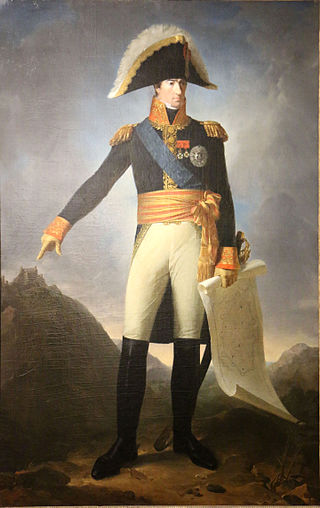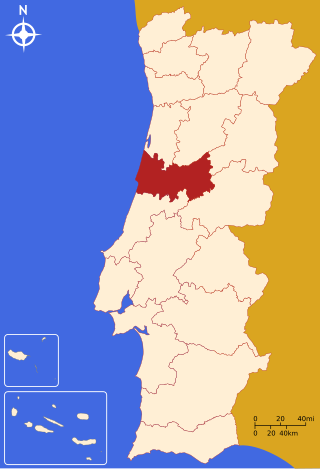
At the Battle of Fuentes de Oñoro, the British–Portuguese Army under Wellington checked an attempt by the French Army of Portugal under Marshal André Masséna to relieve the besieged city of Almeida.

Honoré Théodore Maxime Gazan de la Peyrière was a French general who fought in the French Revolutionary Wars and the Napoleonic Wars.

At the Battle of Roliça, the first battle fought by the British army during the Peninsular War, an Anglo-Portuguese army under Sir Arthur Wellesley defeated an outnumbered Imperial French division under General of Division Henri François Delaborde, near the village of Roliça in Portugal. The French retired in good order.

The Battle of Buçaco or Bussaco, fought on 27 September 1810 during the Peninsular War in the Portuguese mountain range of Serra do Buçaco, resulted in the defeat of French forces by Lord Wellington's Anglo-Portuguese Army.

Coimbra District is located in the Centro Region, Portugal. The district capital is the city of Coimbra.

General Julien Augustin Joseph Mermet fought in the Napoleonic Wars as a division commander in Italy and in the Peninsular War.

Lousã is a town and municipality in the district of Coimbra, in the central part of Portugal. The population in 2011 was 17,604, in an area of 138.40 km2.

Miranda do Corvo is a town and a municipality in the Portuguese district of Coimbra, with an area of 126.38 square kilometres (48.80 sq mi) and 2011 population of 13,098 inhabitants.

The Combat of the Côa was a military engagement that occurred during the Peninsular War period of the Napoleonic Wars. It took place in the valley of the Côa River and it was the first significant battle for the new army of 65,000 men controlled by Marshal André Masséna, as the French prepared for their third invasion of Portugal.

Louis Henri Loison briefly joined the French Army in 1787 and after the French Revolution became a junior officer. Blessed with military talent and courage, he rapidly rose to general officer rank during the French Revolutionary Wars. He got into difficulties because of his fondness for plundering. In late 1795 he helped Napoleon Bonaparte crush a revolt against the government. After a hiatus, he returned in 1799 to fight in Switzerland where he earned another promotion. In 1800 he commanded a division under Napoleon in the Marengo campaign.
Major-General Sir William Erskine, 2nd Baronet was an officer in the British Army, served as a member of Parliament, and achieved important commands in the Napoleonic Wars under the Duke of Wellington, but ended his service in insanity and suicide.

Jean Gabriel Marchand, 1st Count Marchand went from being an attorney to a company commander in the army of the First French Republic in 1791. He fought almost exclusively in Italy throughout the French Revolutionary Wars and served on the staffs of a number of generals. He participated in Napoleon Bonaparte's celebrated 1796-1797 Italian campaign. In 1799, he was with army commander Barthélemy Catherine Joubert when that general was killed at Novi. Promoted to general officer soon after, he transferred to the Rhine theater in 1800.

In the siege of Ciudad Rodrigo, in Salamanca, Spain, the French Marshal Michel Ney took the fortified city from Field Marshal Andrés Pérez de Herrasti on 10 July 1810 after a siege that began on 26 April. Ney's VI Corps made up part of a 65,000-strong army commanded by André Masséna, who was bent on a third French invasion of Portugal.
Nicholas Trant (1769-1839) was a British Army officer of Irish descent who led Portuguese irregular troops in several actions during the Peninsular War. His best known exploits were the recapture of Coimbra from the French in October 1810 and the successful defense of the line of the Mondego River in March 1811.

The Metro Mondego, part of the mass transit public transport system of Coimbra, Portugal, was to have been a light-rail network that runs above ground in Coimbra into the city's suburbs. Studies and planning were in progress but the Metro Mondego project was cancelled in January 2011 at the height of Portuguese financial crisis. The operational conventional rail line connecting the municipalities of: Coimbra, Miranda do Corvo, Lousã, and Serpins was closed at the same time and replaced by a bus service.

Beira Litoral is a former province (província) of Portugal, formally instituted in an administrative reform of 1936. It was abolished with the 1976 Constitution of Portugal.

The Battle of Redinha was a rearguard action which took place on March 12, 1811, during Masséna's retreat from Portugal, by a French division under Marshal Ney against a considerably larger Anglo-Portuguese force under Wellington. Challenging the Allies with only one or two divisions, Ney's 7,000 troops were pitched against 25,000 men. In a typical rearguard action, Ney delayed the Allied advance for a day and bought valuable time for the withdrawal of the main body of the French army.

The Battle of Pombal was a sharp but ultimately indecisive skirmish fought at the eponymous town during Marshal Masséna's retreat from the Lines of Torres Vedras, the first in a series of lauded rearguard actions fought by Michel Ney. The French were pursued by Wellington and his British-Portuguese army but the Allied advance was energetically contested by Ney's efforts, preventing Wellington from crushing Masséna's army when it was critically vulnerable.

Pierre-Louis Binet de Marcognet joined the French army in 1781 as an officer cadet and fought in the American Revolutionary War. During the French Revolutionary Wars he fought in the Army of the Rhine and was wounded at First and Second Wissembourg. After being dismissed from the army for a year and a half for having noble blood, he resumed his military career and was wounded at Biberach and Kehl. Promoted to lead the 108th Line Infantry Demi-Brigade, he was in the thick of the fighting at Hohenlinden in 1800, where he was wounded and captured.

The Battle of Foz de Arouce was an engagement of the Peninsular War which took place on 15 March 1811 between Anglo-Portuguese forces under Arthur Wellesley and French troops under the command of Marshal Michel Ney.



















